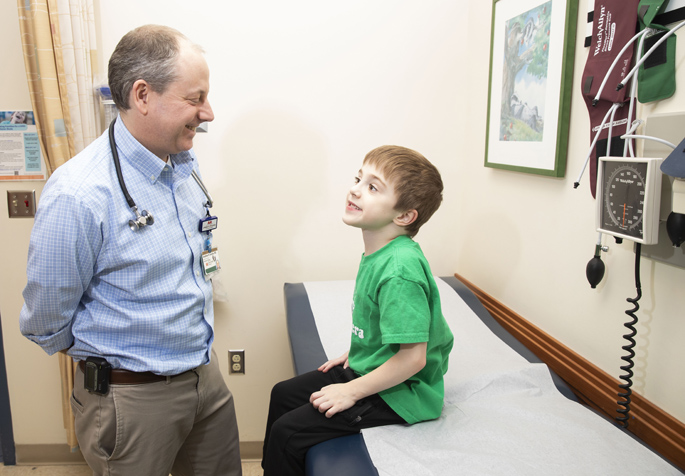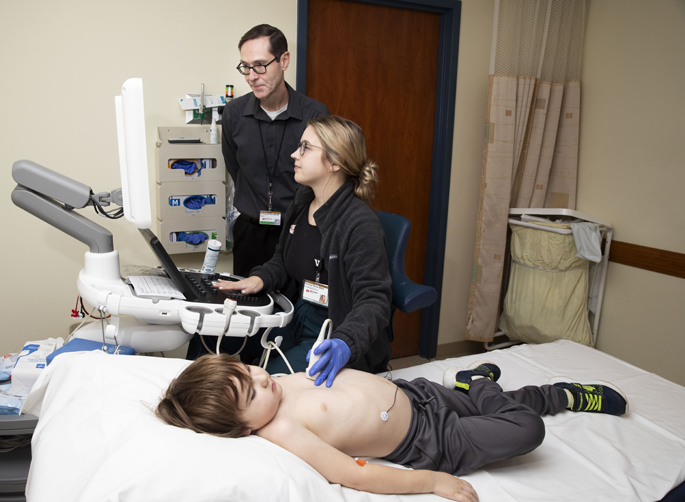
Five months after the FDA approved ELEVIDYS, a gene therapy for Duchenne muscular dystrophy (DMD), Jonathan Soslow, MD, and Bryan Burnette, MD, began following the first two patients to receive the novel infusion at Monroe Carell Jr. Children’s Hospital at Vanderbilt.
Duchenne is a rare, genetic disorder characterized by the progressive damage and weakness of the muscles caused by mutations in the dystrophin gene, which is essential to keeping muscle cells intact. Over time, DMD becomes fatal as muscle degeneration disrupts lung and heart function.
Soslow, one of three co-directors of the Duchenne Muscular Dystrophy Clinic at Monroe Carell, isn’t sure what the long-term effect of the treatment holds for his patients.

But he is certain of one thing — the $3.2 million, one-time infusion is providing a huge dose of hope to patients, families and medical professionals.
“Many years have gone into developing this therapy, and generations of Duchenne patients have advocated for this, knowing full well that they would never receive the therapy,” said Soslow, professor of Pediatrics and Cardiology.
“It’s not a cure, but the next step. Hope is a huge thing. “Parents will do anything for their children to make their lives better. The hope this treatment brings is incredible — the idea or chance that this can alter the progression of the disease and make a child’s life better is indescribable,” said Soslow, who also holds the Dr. William R. Long Directorship in Pediatric Research.
The gene therapy team wants to make sure the treatment is available to all patients who are eligible and need it, like Oliver Hutson from Chattanooga, Tennessee.
Hutson was the first patient at Monroe Carell to receive ELEVIDYS (delandistrogene moxeparvovec-rokl), developed by Sarepta Therapeutics for the treatment of ambulatory pediatric patients who are 4 to 5 years old with DMD with a confirmed mutation in the DMD gene. It is designed to target the underlying cause of the disease.
Andrea White, Oliver’s mother, recalls sharing with her son about his diagnosis and why he was receiving the new treatment.
“I explained that his muscles were a little bit different than others and that was why his legs get so tired,” she said. “We told him that that is why we are getting the medicine, and it should help him.
“I am hoping that it will lengthen his walking time and that this protects his muscles so that he doesn’t have as much muscle loss and stays ambulatory for as long as possible,” said White.
The family is aware of the typical progression of DMD, which propelled them to seek the most innovative treatment options for Oliver, who will be enrolled in a study to provide additional data for future patients.
“We know it’s not a cure, but I feel like I can tell a difference in his running and the way he goes up stairs and gets up from the floor,” said White. “This is 100% worth it. It’s helping his body create some dystrophine, which he didn’t make before.”
Patients receiving gene therapy are also given high doses of steroids, a standard therapy for DMD. For patients treated with ELEVIDYS, the steroid dose is boosted to reduce the risk of an early post-treatment inflammatory response against the drug, rather than directly impacting the course of the muscle disease.
“The amount of work that went into administering this medication safely is tremendous,” said Burnette, professor of Clinical Pediatrics and Neurology. “People from administration, pharmacy, the infusion center, and multiple divisions have worked months preparing and continue to collaborate.”
ELEVIDYS uses an adeno-associated virus (AAVrh74) to introduce a shortened version of the DMD gene (micro-dystrophin) partially compensating for their lack of a functional dystrophin protein and addressing the underlying genetic defect that causes DMD.
The clinic at Monroe Carell closely monitors this special group of patients for medication side effects, namely to their hearts.
“There is a lot we don’t know about this medication. We are not sure how long it will work, and we are not sure if it will improve heart function,” said Soslow. “But we do know that it seems to work in improving strength and slowing the progression of disease.”
The second patient, Soren Saxon from North Carolina, was diagnosed the same day of the announcement that ELEVIDYS was approved by the FDA.
“We knew, once he was diagnosed, that we needed to get into a DMD center where the latest treatments and therapies were happening,” said Kelsey Saxon, Soren’s mother.
“We’ve already seen some improvements. We don’t know if it’s the gene therapy or the steroids, but we will take it. He is hopping on one foot, running a lot faster, and he wants to run and race. I look at him and start crying because I can’t believe what this has allowed him to do. This treatment is giving us hope. We sort of feel like pioneers.”
The family has returned to their home in North Carolina and will continue to be followed by the gene therapy team at Monroe Carell.
The team has two additional patients who have begun the application process and a growing roster of interested families.
“We think this generation of patients receiving gene therapy will be stronger, stay out of wheelchairs longer and have a better quality of life,” said Soslow.












